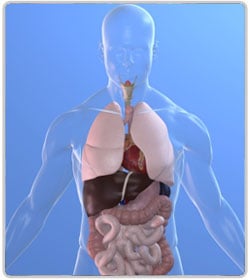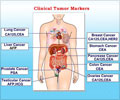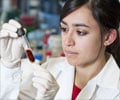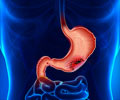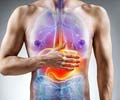- Stomach cancer - (https://en.wikipedia.org/wiki/Stomach_cancer)
- What are the risk factors for stomach cancer? - (http://www.cancer.org/cancer/stomachcancer/detailedguide/stomach-cancer-risk-factors)
- How is stomach cancer diagnosed? - (http://www.cancer.org/cancer/stomachcancer/detailedguide/stomach-cancer-diagnosis)
- About Stomach cancer - (https://medlineplus.gov/ency/article/000223.htm)
- Learn About Stomach Cancer - (http://www.cancer.org/cancer/stomachcancer/)
- Stomach (Gastric) Cancer-Patient Version - (http://www.cancer.gov/types/stomach)
Information About Stomach Cancer / Gastric Cancer
The stomach is a sac like organ and is a part of the digestive system. It is situated in the upper abdomen, below the ribs on the left side of the body. Its upper part connects to the esophagus and its lower part leads into the small intestine. The neighboring organs are the liver, small intestine, pancreas, colon, and spleen.
Cancerous cells that are present in the inner lining of the stomach form the basis of stomach cancer or gastric cancer. It is usually detected only in the advanced stages as initial symptoms are mostly absent.
Types of Stomach Cancer, their Origin and Incidence
Adenocarcinoma is the most common (90-95%) type of stomach cancer. This cancer arises from the innermost lining layer called the mucosa.
Gastrointestinal carcinoid tumors start in hormone-making cells of the stomach and account for 3% of stomach cancers.
Gastrointestinal stromal tumors start in very early forms of cells of the stomach wall called interstitial cells of Cajal.
Lymphomas start in the immune system tissue found in the stomach wall and account for 4% of the stomach cancers.
What are the Stages of Gastric Cancer?
Most stomach cancers start in its innermost layer called the mucosa. This is where the acids and the digestive juices are made. The severity of the cancer increases as it spreads deeper inside from the mucosa to other parts of the stomach wall or to the lymph nodes or to other distant organs.
In the beginning pre-cancerous changes occur in the mucosa but this stage usually goes undetected as it is asymptomatic. Once cancer has been detected there are a few stages used to classify it depending on how much it has spread in the body.
Facts About Stomach Cancer
- According to the National Cancer Institute, 26,370 new cases of gastric cancer are diagnosed in 2016 and about 10,730 cases are likely to die.
- It is the third most common cause of cancer related deaths in the world.
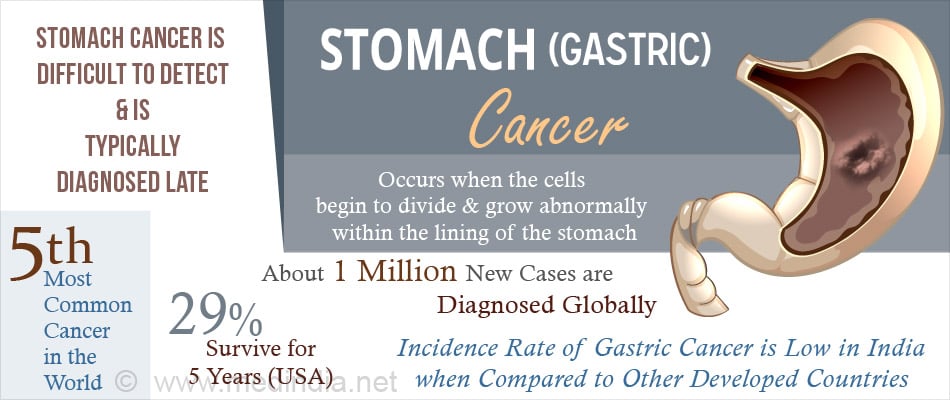
What are the Causes of Gastric Cancer?
Although the cause of stomach cancer is not fully known there are several risk factors involved. They are:
- Being above the age of 50
- Gender - more common in men than women
- Race - more common in black people than in white people.
- Location - more common in some parts of the world - such as Japan, China, Korea, parts of Eastern Europe, and Latin America
- Smoking
- Family history of stomach cancer
- Long standing ulcers or atrophic gastritis caused by Helicobacter pylori infections.
- Stomach lymphomas
- Pernicious anemia
(vitamin B12 deficiency) - Polyps or growths in the stomach
- Menetier disease (decreased acid formation that causes overgrowth of stomach lining)
- Diet - that is high in salt, preserved or smoked products
- When people eat variety of foods that are preserved by drying, smoking, salting or pickling they are at a higher risk of developing stomach cancer.
- Low Fruits and Vegetables in the diet, and high fat content can lead to stomach cancer.
- Exposure to chemical carcinogens like rubber by-products, coal tar and asbestos
- People with Type A blood group
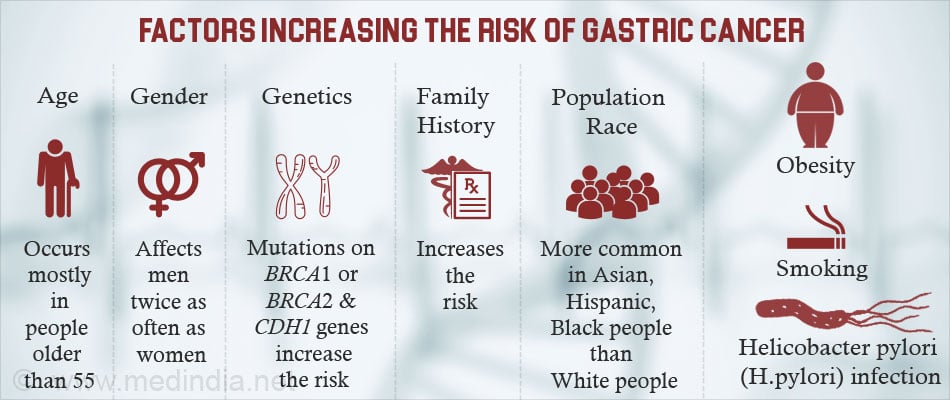
What are the Symptoms of Gastric Cancer?
Stomach cancer can be difficult to detect, often there are NO symptoms in the early stages and, in many cases, the cancer has spread before it is found.
Some of the symptoms associated with stomach cancer are:
- Indigestion or a burning sensation (heartburn)
- Discomfort or
pain in the abdomen - Nausea and vomiting
- Difficulty swallowing
- Diarrhea or constipation
- Bloating of the stomach after meals
- Loss of appetite
- Weakness and fatigue
- Persistent low grade fever
- Black tarry stools
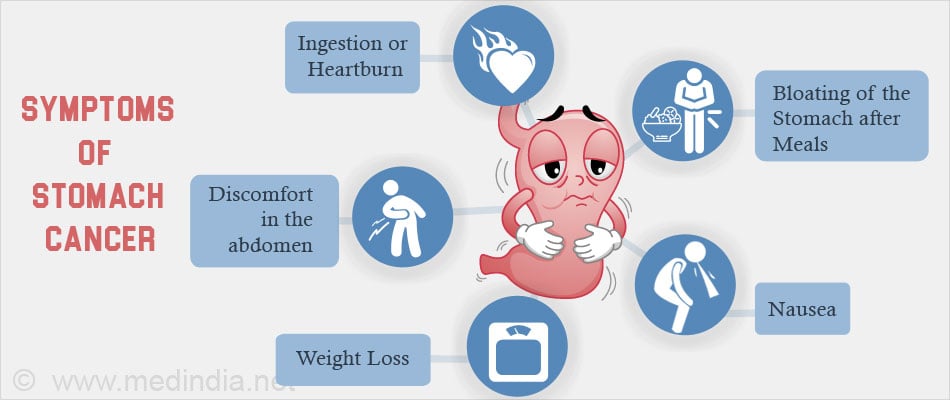
How do you Diagnose Gastric Cancer?
The first step involves undergoing a general physical examination and a discussion with the doctor of your medical history.
Upper endoscopy (also called esophagogastroduodenoscopy or EGD) is usually the first test that is done to detect stomach cancer. An endoscope (a thin, flexible, lighted tube) fitted with a small video camera is inserted down the throat to view the stomach.
An Endoscopic Ultrasound (EUD) is later done to see how far the cancer has spread to the stomach walls, neighboring tissues and lymph nodes. In this case the endoscope is used to insert a small ultrasound device into the stomach to generate a close-up image of your stomach on a computer screen.
If abnormal masses are seen, a biopsy is done (either during EGD or EUD). The removed cells or tissue are examined under a microscope to check the presence and kind of cancer.
Imaging tests mostly performed for stomach cancer are:
X-rays (using the barium swallow) to look at the inner lining of the stomach
Computed Tomography (CT scan) that confirm the location of the cancer and show the spread to nearby organs such as the liver, lymph nodes and pancreas can also be done. A CT scan also determines the stage of the cancer and whether surgery may be a good treatment option.
Chest x-ray: Chest x-rays are often performed to find out if the cancer has spread to the lungs.
Apart from this, laboratory tests like Complete Blood Count (CBC) to look for anemia and Fecal Occult Blood test(to detect blood in the stools) are also done.

How do you Treat Gastric Cancer?
The best approach to treat cancer uses two or more of the following methods:
- Chemotherapy
- Radiation
- Surgery
- Targeted Therapy
In Chemotherapy drugs are taken orally or through IV. Chemotherapy is provided in two ways.
Neoadjuvant treatment: Given prior to the surgery with an aim of shrinking the tumour.
Adjuvant treatment; Given post surgery to kill cancer cells that cannot be removed completely or too small to see. In the case of stomach cancer, adjuvant chemo is mostly accompanied with radiation therapy - this is known as chemoradiation.
Sometimes chemo is the only option in advanced cancers when surgery is not an option. It is given just to alleviate the pain in patients and to prolong life.
Chemotherapy drugs:
A dose / cycle of chemotherapy usually lasts for a few weeks followed by a rest period. Common drugs are:
- Fluorouracil (5-FU) injection or its analog Capecitabine block DNA replication thus killing the cancerous cells.
- Cisplatin platinum-containing anti-cancer drugs and
- Carboplatin bind to DNA, delink its strands and lead to programmed cell death.
- Paclitaxel and Docetaxel work by interfering with the normal breakdown of microtubules during cell division
- Epirubicin and Doxorubicin interfere with DNA and RNA synthesis
Several combination treatments used are:
- ECX (epirubicin, cisplatin, and capecitabine)
- Epirubicin, cisplatin and fluorouracil (5FU).
- Docetaxel / paclitaxel and 5-FU / capecitabine
- Cisplatin and 5-FU / capecitabine
- Paclitaxel and carboplatin
Targeted Therapy:
Trastuzumab - used to treat HER2 positive adenocarcinoma
Ramucirumab - given alone or in combination and used in advanced or metastasized stomach cancer
Nausea / vomiting, hair loss and diarrhoea are some of the main side effects of chemotherapy.
Radiation uses high-energy waves or particles to kill cancer cells. This can be done before and / or after surgery either alone or in combination with chemotherapy (for eg. with 5-FU)
External beam radiation therapy involves transmitting radiation from a machine outside the body to treat stomach cancer.
It also causes side effects like nausea / vomiting and loss of appetite especially when given in addition to chemo.
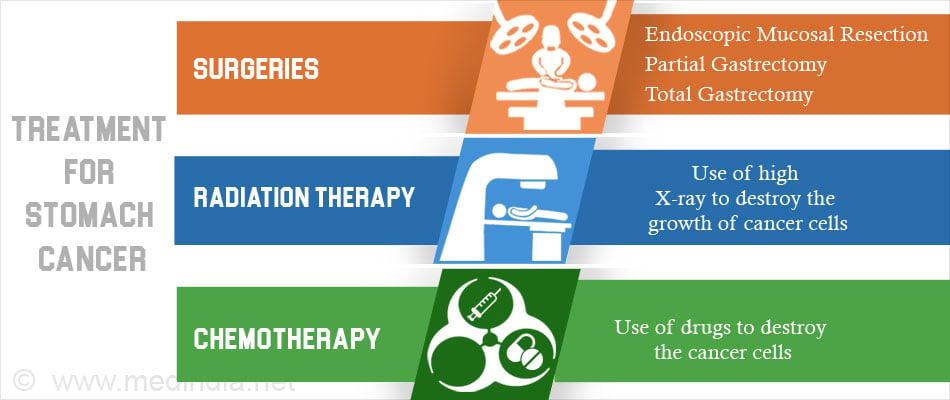
Surgery for Gastric Cancer
Depending on the type and the stage of cancer, surgery is used as a part of the treatment procedure.
During very early stages when the cancer has not spread to the lymph nodes, an endoscopic resection of the mucosa and the submucosa can be done. The advantage to this method is that there is no skin lesion and the endoscope (inserted via the throat) is used to removed the tumour and part of the normal stomach wall.
For advanced stages, a gastrectomy is done that involves removing either a part (subtotal or partial gastrectomy) or all (total gastrectomy) of the stomach, as well as some of the tissue around the stomach. After a subtotal gastrectomy, the doctor connects the remaining part of the stomach to the esophagus or the small intestine. After a total gastrectomy, the doctor connects the esophagus directly to the small intestine.
Gastric Cancer Treatment According to its Stages
Cancer stages are classified according to how far they have metastasized or spread:
Stage 0 - Cancerous cells present only in the innermost lining. It is usually treated by endoscopy mucosal reduction or by total or partial gastrectomy and removal of neighboring lymph nodes without chemotherapy or radiation.
Stage 1 - Cancerous cells spread to the second or third layers of stomach (1A) or second layer and to a couple of lymph nodes (1B). In this case, a total or partial gastrectomy along with lymph node removal and omentum removal is performed that can sometimes be preceded by chemotherapy. If the cancer is still present in the lymph nodes post surgery, chemotherapy or chemoradiation is an option.
Stage 2 - Spread to second layer and more distant lymph nodes, or third layer and nearby lymph nodes or all four layers but no lymph nodes
Stage 3 - Spread to third layer and more distant lymph nodes or fourth layer and either nearby tissues or nearby or more distant lymph nodes
For stages 2 and 3 cancer, surgery is done to remove all or part of the stomach and the lymph nodes preceded by chemotherapy and followed by chemotherapy and/or chemoradiation. A cure is still possible for a stage 3 cancer.
Stage 4 - Spread to nearby tissues and more distant lymph nodes or to distant organs like liver, lungs, brain or bones thus minimizing chances for a cure. Surgery, chemotherapy, radiation, chemoradiation are all the options and mostly given to relieve symptoms and prolong life.
Sometimes, targeted therapy is an option for advanced stages (for example Trastuzumab (Herceptin) is given to patients whose tumors are HER2-positive. HER2 or human epidermal growth factor receptor (HER2) is a gene that cancer cells overexpress.
Gastric Cancer Prognosis and Survival Rate
Survival rates are a standard way to discuss the prognosis or outlook of a person. This rate is affected by their general health, location of the cancer, the treatment (surgery or not), the patient’s response to the treatment and their physical fitness. In general, there is around 80% chance of survival of a cancer patient with who has early stage symptoms. This percentage decreases as the stage or the severity of the disease increases and we see only around 5 % survival rate for a stage 4 cancer patient.
Gastric Cancer Prevention
Although the onset of gastric cancer cannot be prevented there are a few steps that can be taken to reduce its risk:
- Increase consumption of vegetables and fruits
- Use the refrigerator as a means for food storage as opposed to pickling or smoking
- Regular physical exercise
- Cut down on alcohol and tobacco consumption.
- Complete treatment of H. Pylori infected patients with antibiotics
- Prevent development of polyps which could lead to cancerous cells
- Take smaller frequent meals.
- Taking prescription of vitamins may help you maintain your body's proper level of vitamins. Some of these vitamins can be taken only by injection. (eg. Vit B12).
- Know what to expect. Find out everything about the cancer - the type, stage, treatment options and their side effects. The more you know, the more active you can be in your own care. In addition to talking with your doctor, look for information in your local library and on the Internet.
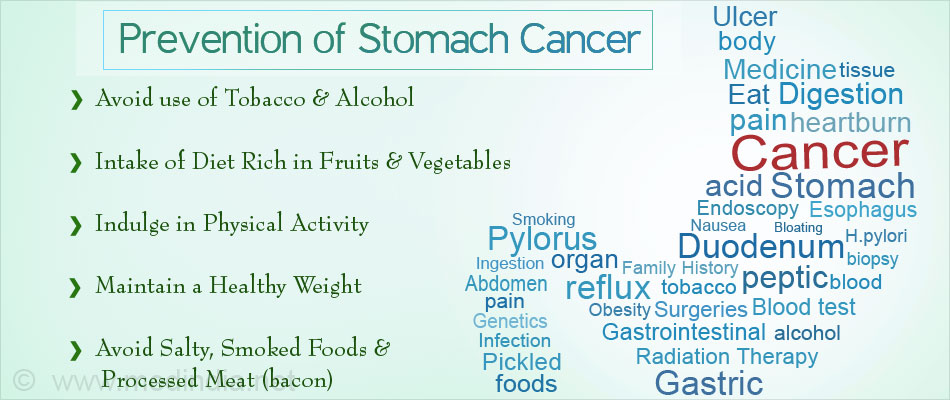
Gastric Cancer Clinical Trials
Clinical trials are an option for patients who are in the advanced stages of cancer where surgery is not an option. By taking part in clinical trials they will be lending a hand to new research that is being done in the field of cancer.
An ongoing Phase 3 trial is studying how aspirin (a drug given to patients to prevent heart attacks and strokes) can prevent cancer relapse. This is based on earlier research that has concluded that patients taking aspirin are less likely to acquire cancer.
Another study assessed the safety and efficacy of a drug called ramucirumab, when given in addition to trastuzumab and chemotherapy in patients with HER2-positive metastatic stomach and gastroesophageal junction cancer. Ramucirumab acts by blocking the activity of a protein called VEGFR2 present on cancer cells.


